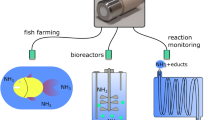Abstract
We report on an optical sensor material suitable for fluorimetric measurement of pH in the 6–9 range using a new, fully LED-compatible fluorescent dye. Its base form has a strong absorption between 580 and 630 nm that matches the emission band of conventional yellow or orange light-emitting diodes. Two kinds of dye immobilization are reported. The first is based on covalent binding to a cellulosic matrix and the resulting material is intended for use in sensing membranes. The second involves physical entrapment of the dye in a sol-gel matrix which can be used for optical fiber tip coating as well as in evanescent wave type sensors. Both kinds of sensor materials are studied with respect to dynamic pH ranges, response times, sensitivity toward ion strength, and stability.
Similar content being viewed by others
References
L. A. Saari, W. R. Seitz,Anal. Chem. 1982,54, 821.
Z. Zhujun, W. R. Seitz,Anal. Chim. Acta 1984,160, 47.
B. G. Harper,Anal Chem. 1975,47, 348.
J. I. Peterson, S. R. Goldstein, R. V. Fitzgerald, D. K. Buckhold,Anal. Chem. 1980,52, 864.
G. F. Kirkbright, R. Narayanaswamy, N. A. Welti,Analyst 1984,109, 1025.
K. T. V. Grattan, Z. Mouaziz, A. W. Palmer,Biosensors 1987/88,3, 17.
M. J. P. Leiner, O. S. Wolfbeis, in:Fiber Optic Chemical Sensors and Biosensors, Vol. 1 (O. S. Wolfbeis, ed.), CRC Press, Boca Raton, Florida, 1991, Chapter 8.
H. Offenbacher, O. S. Wolfbeis, E. Fürlinger,Sensors & Actuators 1986,9, 73.
J. C. Sheehan, J. Preston, P. A. Cruikshank,J. Am. Chem. Soc. 1965,87, 2492.
O. S. Wolfbeis, L. J. Weis, M. J. P. Leiner, W. E. Ziegler,Anal. Chem. 1988,60, 2028.
D. Levy, D. Avnir,J. Photochem. Photobiol. A. Chem. 1991,57, 41.
V. R. Kaufman, D. Avnir,J. Non-Crystalline Solids 1988,99, 379.
J. E. Whitaker, R. P. Haugland, F. G. Prendergast,Biophys. J. 1988,53, 197.
J. Janata,Anal. Chem. 1987,59, 1351 (and references cited therein).
O. S. Wolfbeis, H. Offenbacher,Sens. Actuators 1986,9, 85.
T. E. Edmonds, N. J. Flatters, C. F. Jones, J. N. Miller,Talanta 1988,35, 103.
L. G. Lee, G. M. Berry, C. H. Chen,Cytometry 1989,10, 151.
E. T. Knobbe, B. Dunn, M. Gold,Proc. SPIE (Soc. Photoinstrum. Engs.) 1989,906, 39.
Author information
Authors and Affiliations
Additional information
Dedicated to Professor G. Werner, Leipzig, on the occasion of his 60th birthday.
Rights and permissions
About this article
Cite this article
Wolfbeis, O.S., Rodriguez, N.V. & Werner, T. LED-compatible fluorosensor for measurement of near-neutral pH values. Mikrochim Acta 108, 133–141 (1992). https://doi.org/10.1007/BF01242422
Received:
Revised:
Issue Date:
DOI: https://doi.org/10.1007/BF01242422




